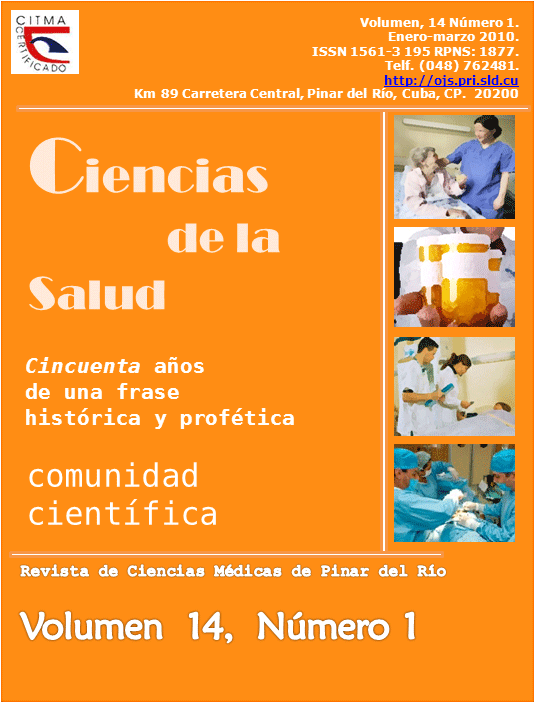Nephrolithiasis of infection: clinical case
Abstract
A clinical case of lithiasis of infection is presented, known as calculi of struvite associated to an underlying metabolic disease and diabetes mellitus type-2 of recent onset, with oliguria and infection as a result of a partial bilateral urinary infection. A 48 years-old patient having medical records of ischemic heart disease, hypertension and expulsion of kidney stones attended to the office in January 21, 2009 presenting normal values of creatinine, glycemia and uric acid before the admission; these values increased during the obstruction, except the uric acid. Renal and prostate imaging, the Uro-Computerized axial tomography and renal scintigraphy with MAG-3 showed data of interest. Differential diagnosis included extrinsic and intrinsic causes, the last one related to calculi, clots or renal necrotic papilla causing disorder of the free urinary flow. Patterns of good progress were established: recovery of the urinary volume, normal levels of glycemia and creatinine and a permanent negative uroculture. Therapeutic management motivated the use of percutaneous nephrolithotomy as one of the choices for endourologic procedures, as well as the control of the underlying diseases, being favorable for a good progress of the case.Downloads
References
1. Johnson CM, Wilson DM, O Fallon WN. Renal stones epidemiology: A 25 years study in Rochester, Minnesota. Kidney Int.1979; 16:629-31.
2. Chute R, Suby HI. Prevalence and importance of urea splitting bacterial infection of the urinary tract in the formation of calculi.Jurol .1943; 144:590.
3. Griffith DP, Musher Dm. Acetohydroxamicacid:Potencial use in urinaryinfections by urea-splitting-bacteria. Urology. 1975; 5:299.
4. Segura JW, Patterson DE, Le Roy AJ .Long-term follow up of patients treated by percutaneous ultrasonic lithotripsy for struvite staghorn calculi. J Endourol.1987; 1:177.
5. Martínez C., Guzmán S, Marzari A. et al: Estado actual de la cirugía de la urolitiasis en la Universidad Católica, años 1996-1997. Rev. Chil. Urol. 1999, 64: p.223
6. Consuegra Silverio DI, et al. Determinación de la Composición Química de los Cálculos Renales. Tesis para optar por el grado de Master en Bioquímica. Universidad de la Habana; 2004.
7. Reyes Rabanal L. Estudio Comparativo de Comportamiento Clínico-Epidemiológico de la Urolitiasis en dos poblaciones diferentes de Cuba. Revista Portuguesa de Nefrología e Hipertensión. 2004, 18(3): p.155
8. Torres A. Litiasis Renal. Tratado de Nefrología [en internet]. Vol. 1; 835. Editorial Prado; 2003. Disponible en: http://www.librospdf.net/TRATADO-DE-NEFROLOGIA/2/-España
9. Mañalich R. Evaluación Diagnóstico de la Litiasis Renal. Tratado de Nefrología [en internet]. 2003, [citado 23 de Julio de 2008]; Vol. 1; 849. Editorial Prado; 2003. Disponible en: http://www.hospitalameijeiras.sld.cu/.../ENFERMEDAD%20LITIASICA%20RENAL.pdf
10. Castillo JM. Litiasis Renal. Nefrología Clínica. Barcelona: Panamericana; 2003.
Published
How to Cite
Issue
Section
License
Authors who have publications with this journal agree to the following terms: Authors will retain their copyrights and grant the journal the right of first publication of their work, which will be publication of their work, which will be simultaneously subject to the Creative Commons Attribution License (CC-BY-NC 4.0) that allows third parties to share the work as long as its author and first publication in this journal are indicated.
Authors may adopt other non-exclusive license agreements for distribution of the published version of the work (e.g.: deposit it in an institutional telematic archive or publish it in a volume). Likewise, and according to the recommendations of the Medical Sciences Editorial (ECIMED), authors must declare in each article their contribution according to the CRediT taxonomy (contributor roles). This taxonomy includes 14 roles, which can be used to represent the tasks typically performed by contributors in scientific academic production. It should be consulted in monograph) whenever initial publication in this journal is indicated. Authors are allowed and encouraged to disseminate their work through the Internet (e.g., in institutional telematic archives or on their web page) before and during the submission process, which may produce interesting exchanges and increase citations of the published work. (See The effect of open access). https://casrai.org/credit/



